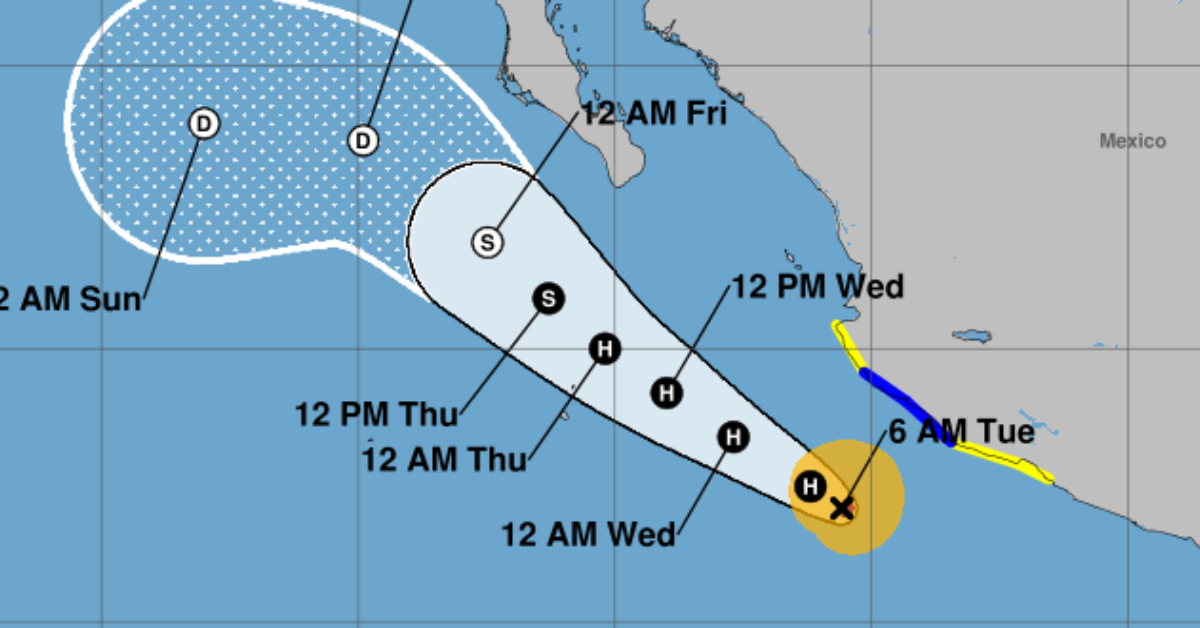Hurricane Flossie intensifies off Mexico’s Pacific coast with winds near 90 mph. Heavy rain, flooding, and tropical storm conditions expected in parts of Guerrero, Michoacán, Colima, and Jalisco.
Hurricane Flossie continued to intensify early Tuesday morning as it moved west-northwestward off the coast of southwestern Mexico, prompting tropical storm warnings and watches across multiple states. As of 6:00 a.m. CST, the storm was located about 155 miles (250 kilometers) south-southwest of Manzanillo, Colima, packing maximum sustained winds of 90 mph (145 km/h), according to the National Hurricane Center (NHC) in Miami.
The storm’s forward movement was measured at 10 mph (17 km/h), and it’s expected to slow slightly while continuing in the same general direction over the next couple of days. While the center of Flossie remains offshore, its outer bands are already impacting coastal areas.
Warnings and Watches in Effect
A Tropical Storm Warning is currently in effect from Punta San Telmo to Playa Perula, indicating tropical storm conditions are expected within 36 hours. A Tropical Storm Watch is also in effect for areas east of Punta San Telmo to Zihuatanejo, and north of Playa Perula to Cabo Corrientes, where conditions could develop within the next 48 hours.
Residents along Mexico’s Pacific coast are urged to monitor updates from local authorities and heed any official guidance, particularly in flood-prone or mountainous regions.
Rainfall and Flooding Threat
Flossie is expected to bring 2 to 4 inches of rain, with localized totals of up to 6 inches, across portions of Guerrero, Michoacán, Colima, and Jalisco through Wednesday. The NHC warned that this rainfall could lead to life-threatening flash floods and mudslides, especially in areas with steep terrain.
In a statement, the agency emphasized that while Flossie is not expected to make landfall, its outer bands could still produce dangerous conditions on land.
Storm Surge and Surf Conditions
Swells generated by the storm are already reaching southwestern Mexico’s coastline and are expected to continue through the next few days. These conditions are likely to produce dangerous surf and rip currents, posing a threat to beachgoers and small vessels.
Local authorities have advised residents and visitors in affected coastal areas to avoid swimming or boating until the storm passes.
Storm Strength and Forecast
Satellite data and recent scatterometer passes indicate that Flossie has continued to intensify overnight. The National Hurricane Center now estimates sustained winds at 75 knots (90 mph) with higher gusts, based on Dvorak satellite intensity estimates and improved central storm structure.
The storm remains in a favorable environment for further strengthening today, with warm ocean temperatures, ample mid-level moisture, and low wind shear. NOAA models predict a greater than 40 percent chance that Flossie could intensify by 25 knots (approx. 29 mph) within 24 hours. If this rapid intensification occurs, Flossie could reach Category 2 status before weakening begins late Wednesday.
However, weakening is expected to begin within 48 hours as the system encounters cooler sea surface temperatures and dry mid-level air, which will erode the storm’s core structure. The NHC predicts Flossie will become a post-tropical low by Thursday night and a remnant low by the weekend.
A Close Call for the Coast
Although Flossie’s center is forecast to stay offshore, its proximity to land means there’s little room for complacency. Tropical-storm-force winds extend outward up to 90 miles (150 kilometers) from the center, increasing the risk of wind damage, particularly to coastal infrastructure, crops, and trees.
The minimum central pressure of the storm was measured at 979 mb (28.91 inches), another sign of the system’s strengthening overnight.
Preparedness Urged
Authorities across southwestern Mexico have advised residents to prepare for strong winds, localized flooding, and potential evacuations in vulnerable areas. Emergency services are on alert, and shelters are being prepared in the event of worsening conditions.
For the most accurate and local updates, residents are urged to monitor information from Mexico’s Servicio Meteorológico Nacional (SMN) and civil protection agencies. Updates are also available on hurricanes.gov with rainfall graphics and forecast tracks.
Hurricane Flossie intensifies off Mexico's Pacific coast with winds near 90 mph. Heavy rain, flooding, and tropical storm conditions expected in . . .












